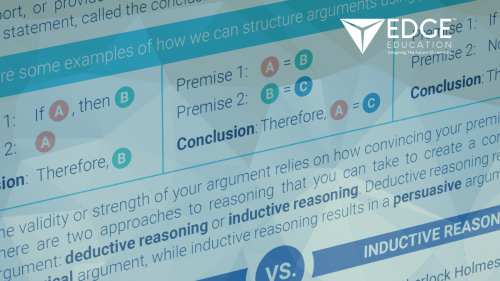Good academic writing relies on a solid argument structure. In this infographic, our Academic Manager, Nadia Ellis, provides an overview of what an argument is, and outlines different approaches to structuring an argument successfully (click infographic to enlarge).
Share this Image On Your Site
Structuring an Argument – content
Arguments consist of two kinds of statements: premises and conclusions.
Premise vs. Conclusion
Premise – a statement or claim that is either true or false. This statement aims to support, or provide evidence for, the final statement, called the conclusion.
Conclusion – a statement or claim that is supported by another preceding statement(s) in the argument, known as the premise.
Below are some examples of how we can structure arguments using premises and conclusions.
- Premise 1: If A, then B
Premise 2: A
Conclusion: Therefore, B - Premise 1: A = B
Premise 2: B = C
Conclusion: Therefore, A = C - Premise 1: If A, then B
Premise 2: Not A
Conclusion: Therefore, not B
The validity or strength of your argument relies on how convincing your premises are. There are two approaches to reasoning that you can take to create a convincing argument: deductive reasoning or inductive reasoning. Deductive reasoning results in a logical argument, while inductive reasoning results in a persuasive argument.
Deductive Reasoning vs. Inductive Reasoning
Deductive Reasoning
Aristotelian Method – moves from generalisations or theory to specific observations
Premise 1: All human beings are mortal.
Premise 2: I am a human being.
Conclusion: Therefore, I am mortal.
Inductive Reasoning
Sherlock Holmes Method – moves from specific observations to generalisations or theory
Premise 1: Karen is a teacher.
Premise 2: All teachers like children.
Conclusion: Therefore, Karen likes children.
When writing your article, use your basic argument structure to plan your content. Your goal is ultimately to convince the reader that your premises are true. If you can do that, your conclusion will follow effortlessly, and your argument will be logical or persuasive. Note, however, that not all premises need an extensive defence. Some, like ‘all humans are mortal’, are generally accepted. In such cases, rather use your space to support less evident premises.





One Response
Thank you for sharing this knowledge.